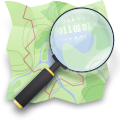| Leaflet | |
|---|---|
 | |
| Original author | Volodymyr Agafonkin |
| Initial release | May 13, 2011 |
| Stable release | 1.9.4 [1] |
| Repository | |
| Written in | JavaScript |
| Platform | See Browser support |
| Type | JavaScript library |
| License | BSD-2-Clause [2] |
| Website | leafletjs |
Leaflet is a JavaScript library used to build web mapping applications. It allows developers without a GIS background to display tiled web maps hosted on a public server, with optional tiled overlays. It can load feature data from GeoJSON files, style it and create interactive layers, such as markers with popups when clicked.
Contents
- Use
- Features
- Elements
- Support for GIS formats
- Browser support
- Examples of useful features
- Comparison with other libraries
- History
- References
- External links
First released in 2011, [3] it supports most mobile and desktop platforms, supporting HTML5 and CSS3. Among its users are FourSquare, Pinterest, Flickr, and the USGS.
Leaflet is open source, and is developed by Ukrainian developer Volodymyr Agafonkin, who joined Mapbox in 2013. [4]

